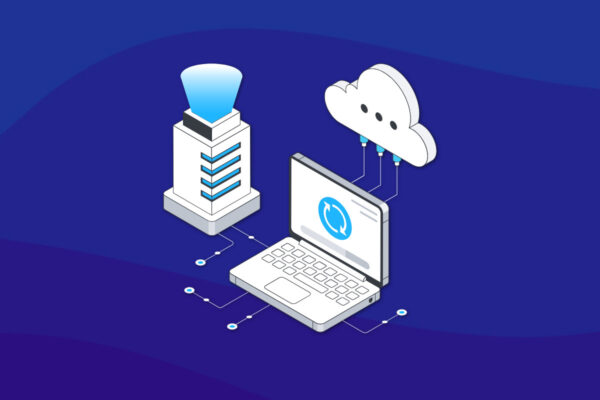Why having backups isn’t enough
No business is immune to data loss and downtime. Many organizations assume that having a backup strategy is enough to ensure business continuity. Unfortunately, that assumption can be costly. While backups are vital for data protection, they often fall short in ensuring full operational recovery when disaster strikes.
In today’s always-on business environment, even minimal downtime can lead to missed revenue, compliance failures and reputational harm. Simply having a copy of your data isn’t enough. You need a strategy that guarantees access, uptime and productivity.
This blog explores why backups alone aren’t sufficient for true resilience and how a comprehensive business continuity and disaster recovery (BCDR) solution bridges the gap between protecting data and keeping your business running.
Backups protect data, but don’t mitigate downtime
Backups safeguard your data, but they don’t always ensure recoverability or continuity. Traditional backup solutions primarily focus on storing copies of data, not on restoring systems, applications or operations quickly after a disruption. When a system fails or ransomware strikes, businesses that rely only on backup can face hours or even days of downtime before they are fully operational again. During that time, employees are idle, customers can’t be served and revenue stops.
For genuine resilience, your data protection strategy must go beyond backup. It should prioritize minimizing downtime and maintaining operational continuity, both of which depend on recovery time objectives (RTOs) and recovery point objectives (RPOs). By measuring how quickly systems can be restored (RTO) and how much data can be lost between backups (RPO), businesses gain clarity on whether their current solution truly supports continuity or simply partial recovery.
Every minute of downtime costs money, productivity and reputation. To understand the real impact of downtime on your business, try Datto’s RTO calculator and see how quickly those costs can add up.
Where backups fall short
Backups form the foundation of any data protection strategy, but they have limitations. In real-world scenarios, backups can fail, become corrupted or simply take too long to restore. Understanding these gaps helps illustrate why modern IT resilience requires a more comprehensive approach — one that not only copies data but ensures rapid, verified recovery.
Let’s explore where and why backups often fall short.
Recovery not guaranteed
A backup is only as good as its ability to restore your systems when disaster strikes. Without proper testing or inclusion of dependencies and configurations, a backup may appear successful but fail during restoration. Unverified backups leave businesses vulnerable to data loss and prolonged downtime.
Unfortunately, many organizations don’t realize their backups are unusable until a crisis occurs. In these moments, every second counts. Employees are locked out of critical systems, customers cannot access services and leadership is left scrambling to communicate next steps. What looked like a safety net quickly becomes a liability when recovery stalls.
Potential for corruption
Corruption, incomplete copies and compromised integrity can make backup data unusable. Common threats include:
- Ransomware and cyberthreats: Connected or unprotected backups are prime targets for encryption, deletion or tampering during cyberattacks.
- Natural disasters and local events: Fire, flooding or power outages can destroy on-premises or local backups.
- Human error or unauthorized alteration: Accidental deletions, overwrites or malicious modifications can compromise your backups.
When corruption occurs, organizations often discover the issue too late, typically when trying to recover after an incident. The result is wasted time, incomplete recovery and the potential loss of irreplaceable business data. Even cloud-based backups are not immune if credentials are compromised or infected files replicate automatically.
Outdated systems
Relying on legacy or unsupported backup software can leave modern workloads exposed. As infrastructure evolves with hybrid work, SaaS applications and cloud workloads, legacy tools often lack the flexibility and speed required to keep businesses protected. Risks include:
- Insufficient backup frequency: Long gaps between backups make it difficult to meet aggressive RPOs.
- Single points of failure: Storing backups on one device or site increases vulnerability.
- Slow recovery times: Traditional backups can take hours — or even days — to restore, resulting in extended downtime.
- Capacity and storage limits: As data volumes grow, older systems struggle to keep pace, leading to incomplete backups.
- Compliance challenges: Failure to meet retention, encryption or testing standards can lead to costly penalties.
These limitations cause more than technical headaches. They can disrupt productivity, delay customer service and undermine compliance readiness. As infrastructure becomes more distributed and data volumes increase, outdated systems simply cannot keep pace with modern business demands.
Infrastructure outages
Power failures, network interruptions or hardware malfunctions can prevent backups from completing or make recovery from affected systems impossible. Without off-site replication or cloud integration, businesses risk losing both their primary and backup data simultaneously. In these cases, downtime can stack up as teams attempt to rebuild lost systems from scratch. A single localized incident, such as a flood or power surge, can cause total data loss when backups exist in the same environment, bringing operations to a complete halt.
How BCDR solutions address backup limitations
Modern BCDR solutions go beyond storing data. They make sure you can access and restore systems exactly when you need them. Think of BCDR as the evolution of backup, preserving your data while ensuring your business can keep operating without interruption. Here’s how BCDR fills the gaps left by traditional backup strategies:
Automated backups
BCDR systems backup data continuously or at frequent intervals, ensuring that data is always current. This near-continuous protection helps meet even the most demanding RPOs by addressing the risk of outdated or incomplete backups that occur when systems rely on manual processes or infrequent scheduling. By removing human error and reducing time gaps between backups, businesses minimize the risk of data loss and ensure that recovery points are always recent and reliable.
Backup immutability
Immutable backups cannot be modified or deleted, making them resistant to ransomware and unauthorized access. These eliminate one of the biggest vulnerabilities of traditional backups — the risk of data corruption or tampering. Even if attackers infiltrate a network or encrypt production systems, immutable copies remain untouched and recoverable. This layer of protection ensures that organizations always have a clean, unaltered version of their data available for recovery.
Data redundancy
BCDR solutions use cloud replication and off-site storage to create multiple copies of your backups. This redundancy removes single points of failure and guarantees recovery even if one site is compromised. By maintaining data in multiple secure locations, businesses protect themselves against localized disasters, infrastructure outages and on-premises hardware failures. Redundancy ensures that even if one backup location becomes inaccessible, operations can resume quickly using another verified copy. This prevents the complete data loss that often results from storing backups in a single physical environment.
Backup verification
Each backup is automatically verified to confirm data integrity and recoverability. BCDR systems ensure that your backups will actually work as planned in the event of a disaster. This assurance addresses one of the most common and damaging gaps in traditional backups — the false sense of security that comes from untested recovery processes. Automated verification validates that every backup is usable, reducing the risk of discovering corrupted or incomplete files during an emergency. Regular verification builds trust in your recovery plan and eliminates guesswork when downtime strikes.
Disaster recovery testing
Automated disaster recovery testing validates your recovery processes and confirms that systems can be restored quickly and effectively. Frequent testing ensures that businesses are not caught off guard by hidden dependencies or misconfigurations that could derail recovery. It turns theoretical recovery plans into proven processes, ensuring that when an incident occurs, systems and data can be restored within expected timeframes and without unnecessary delay.
Infinite retention
With extended or infinite retention policies, you can preserve historical data for long-term compliance, audits or investigations without worrying about expiration or deletion. This capability resolves compliance and record-keeping challenges that often arise with legacy backup systems. Businesses can retain essential data indefinitely to meet industry regulations, support audits or protect against legal disputes, all while maintaining accessibility and integrity over time.
Failover and virtualization
BCDR solutions use failover and virtualization to maintain operations when outages occur. Failover automatically or manually shifts users and workloads from failed systems to a standby environment, keeping business processes running. Virtualization enables this transition by allowing systems to boot directly from backup images, either on-premises or in the cloud. Together, these capabilities provide near-instant access to applications and data, eliminating one of the biggest weaknesses of traditional backups — slow, manual recovery.
Back up and recover confidently with Datto BCDR
Backups are essential, but ensuring your business can recover from any disruption is critical. Datto BCDR combines powerful data protection, advanced automation and rapid recovery to deliver end-to-end resilience.
With features like five-minute backup frequency, immutable Datto Cloud, automated screenshot verification and instant virtualization, Datto BCDR minimizes downtime and supports uninterrupted operations. Whether you’re facing ransomware, natural disasters or human error, Datto’s unified BCDR platform ensures your data — and your business — are always protected.
Learn more about Datto BCDR and discover how to back up and recover confidently.




